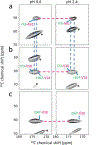Two distinct aggregation pathways in transthyretin misfolding and amyloid formation
- PMID: 30366153
- PMCID: PMC6339575
- DOI: 10.1016/j.bbapap.2018.10.013
Two distinct aggregation pathways in transthyretin misfolding and amyloid formation
Abstract
Misfolding and amyloid formation of transthyretin (TTR) is implicated in numerous degenerative diseases. TTR misfolding is greatly accelerated under acidic conditions, and thus most of the mechanistic studies of TTR amyloid formation have been conducted at various acidic pH values (2-5). In this study, we report the effect of pH on TTR misfolding pathways and amyloid structures. Our combined solution and solid-state NMR studies revealed that TTR amyloid formation can proceed via at least two distinct misfolding pathways depending on the acidic conditions. Under mildly acidic conditions (pH 4.4), tetrameric native TTR appears to dissociate to monomers that maintain most of the native-like β-sheet structures. The amyloidogenic protein undergoes a conformational transition to largely unfolded states at more acidic conditions (pH 2.4), leading to amyloid with distinct molecular structures. Aggregation kinetics is also highly dependent upon the acidic conditions. TTR quickly forms moderately ordered amyloids at pH 4.4, while the aggregation kinetics is dramatically reduced at a lower pH of 2.4. The effect of the pathogenic mutations on aggregation kinetics is also markedly different under the two different acidic conditions. Pathogenic TTR variants (V30M and L55P) aggregate more aggressively than WT TTR at pH 4.4. In contrast, the single-point mutations do not affect the aggregation kinetics at the more acidic condition of pH 2.4. Given that the pathogenic mutations lead to more aggressive forms of TTR amyloidoses, the mildly acidic condition might be more suitable for mechanistic studies of TTR misfolding and aggregation.
Keywords: Amyloid formation; Misfolding; Solid-state NMR; Transthyretin.
Copyright © 2018 Elsevier B.V. All rights reserved.
Conflict of interest statement
Conflict of interest
We hereby declare that the authors have no conflict of interest.
Figures





Similar articles
-
Characterization of the transthyretin acid denaturation pathways by analytical ultracentrifugation: implications for wild-type, V30M, and L55P amyloid fibril formation.Biochemistry. 1998 Dec 22;37(51):17851-64. doi: 10.1021/bi981876+. Biochemistry. 1998. PMID: 9922152
-
Pathogenic Mutations Induce Partial Structural Changes in the Native β-Sheet Structure of Transthyretin and Accelerate Aggregation.Biochemistry. 2017 Sep 12;56(36):4808-4818. doi: 10.1021/acs.biochem.7b00658. Epub 2017 Aug 30. Biochemistry. 2017. PMID: 28820582 Free PMC article.
-
The most pathogenic transthyretin variant, L55P, forms amyloid fibrils under acidic conditions and protofilaments under physiological conditions.Biochemistry. 1999 Oct 12;38(41):13560-73. doi: 10.1021/bi991021c. Biochemistry. 1999. PMID: 10521263
-
Transthyretin Misfolding, A Fatal Structural Pathogenesis Mechanism.Int J Mol Sci. 2021 Apr 23;22(9):4429. doi: 10.3390/ijms22094429. Int J Mol Sci. 2021. PMID: 33922648 Free PMC article. Review.
-
Transthyretin quaternary and tertiary structural changes facilitate misassembly into amyloid.Adv Protein Chem. 1997;50:161-81. doi: 10.1016/s0065-3233(08)60321-6. Adv Protein Chem. 1997. PMID: 9338081 Review.
Cited by
-
A Comprehensive Review on Chemistry and Biology of Tafamidis in Transthyretin Amyloidosis.Mini Rev Med Chem. 2024;24(6):571-587. doi: 10.2174/0113895575241556231003055323. Mini Rev Med Chem. 2024. PMID: 37828667 Review.
-
The Regulatory Mechanism of Transthyretin Irreversible Aggregation through Liquid-to-Solid Phase Transition.Int J Mol Sci. 2023 Feb 13;24(4):3729. doi: 10.3390/ijms24043729. Int J Mol Sci. 2023. PMID: 36835140 Free PMC article.
-
Exploration of the Misfolding Mechanism of Transthyretin Monomer: Insights from Hybrid-Resolution Simulations and Markov State Model Analysis.Biomolecules. 2019 Dec 17;9(12):889. doi: 10.3390/biom9120889. Biomolecules. 2019. PMID: 31861226 Free PMC article.
-
Divergence Entropy-Based Evaluation of Hydrophobic Core in Aggressive and Resistant Forms of Transthyretin.Entropy (Basel). 2021 Apr 13;23(4):458. doi: 10.3390/e23040458. Entropy (Basel). 2021. PMID: 33924717 Free PMC article.
-
Structural Characterization of Cardiac Ex Vivo Transthyretin Amyloid: Insight into the Transthyretin Misfolding Pathway In Vivo.Biochemistry. 2020 May 19;59(19):1800-1803. doi: 10.1021/acs.biochem.0c00091. Epub 2020 Apr 30. Biochemistry. 2020. PMID: 32338497 Free PMC article.
References
-
- Jacobson DR, Pastore RD, Yaghoubian R, Kane I, Gallo G, Buck FS, Buxbaum JN, Variant-sequence transthyretin (isoleucine 122) in late-onset cardiac amyloidosis in black Americans, N. Engl. J. Med, 336 (1997), 466–473. - PubMed
-
- Connors LH, Lim A, Prokaeva T, Roskens VA, Costello CE, Tabulation of human transthyretin (TTR) variants, 2003, Amyloid, 10 (2003), 160–184. - PubMed
-
- Saraiva MJ, Transthyretin mutations in health and disease, Hum. Mutat, 5 (1995), 191–196. - PubMed
-
- Lai ZH, Colon W, Kelly JW, The acid-mediated denaturation pathway of transthyretin yields a conformational intermediate that can self-assemble into amyloid, Biochemistry, 35 (1996), 6470–6482. - PubMed
-
- Lashuel HA, Lai ZH, Kelly JW, Characterization of the transthyretin acid denaturation pathways by analytical ultracentrifugation: Implications for wild-type, V30M, and L55P amyloid fibril formation, Biochemistry, 37 (1998), 17851–17864. - PubMed
Publication types
MeSH terms
Substances
Grants and funding
LinkOut - more resources
Full Text Sources
Research Materials
Miscellaneous

